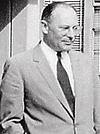You can help expand this article with text translated from the corresponding article in German. Click [show] for important translation instructions.
|
Helmut Hoelzer[5] was a Nazi Germany V-2 rocket engineer who was brought to the United States under Operation Paperclip. Hoelzer was the inventor and constructor of the world's first electronic analog computer.[6]
Helmut Hoelzer | |
|---|---|
| Helmut Hölzer | |
 Helmut Hoelzer in Huntsville, Alabama | |
| Born | February 27, 1912 |
| Died | October 12, 1996 (aged 84) Huntsville, Alabama, United States |
| Alma mater | Technische Hochschule Darmstadt |
| Known for | Designing an electronic simulator for the V-2 rocket control system.[3][4] |
| Awards | Paul Ehrlich and Ludwig Darmstaedter Prize (1963) |
| Scientific career | |
| Fields | Electrical Engineering,[1] Applied mathematics |
| Institutions | 1933-tbd: teaching 1939: Telefunken (Berlin) |
Life edit
In October 1939, while working for the Telefunken electronics firm in Berlin, Hoelzer met with Ernst Steinhoff,[7] Hermann Steuding, and Wernher von Braun regarding guide beams for a flying body.[Neufeld 1] In late 1940 at Peenemünde, Hoelzer was head of the guide beam division[Neufeld 2] (assistant Henry Otto Hirschler[8]), which developed a guide-plane system which alternates a transmitted signal from two antennas a short distance apart, as well as a vacuum tube mixing device (German: Mischgerät)[9] which corrected for momentum that would perturb an object that had been moved back on-track.[Neufeld 3] By the fall of 1941, Hoelzer's "mixing device" was used to provide V-2 rocket rate measurement instead of rate gyros.[Neufeld 4]
Then at the beginning of 1942, Hoelzer built an analog computer to calculate and simulate[8][10][11] V-2 rocket trajectories[Neufeld 5][12] Hoelzer's team also developed the Messina telemetry system.[1] After evacuating Peenemünde for the Alpenfestung (Alpine Fortress), Hoelzer returned to Peenemünde via motorcycle to look for portions of his PhD dissertation[5] prior to surrendering to United States forces at the end of World War II.
Hoelzer was a student of Alwin Walther.[6]
Family edit
One of his grandchildren is Olympic swimmer Margaret Hoelzer.
References edit
Sources edit
- Neufeld, Michael J (1995). The Rocket and the Reich: Peenemünde and the Coming of the Ballistic Missile Era. New York: The Free Press. pp. 104, 106, 107, 140.